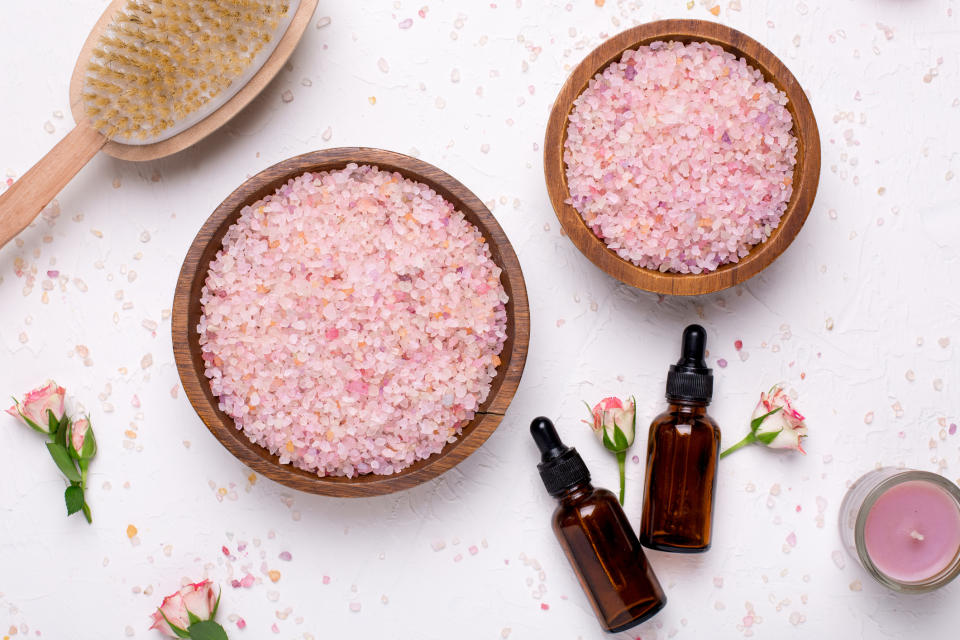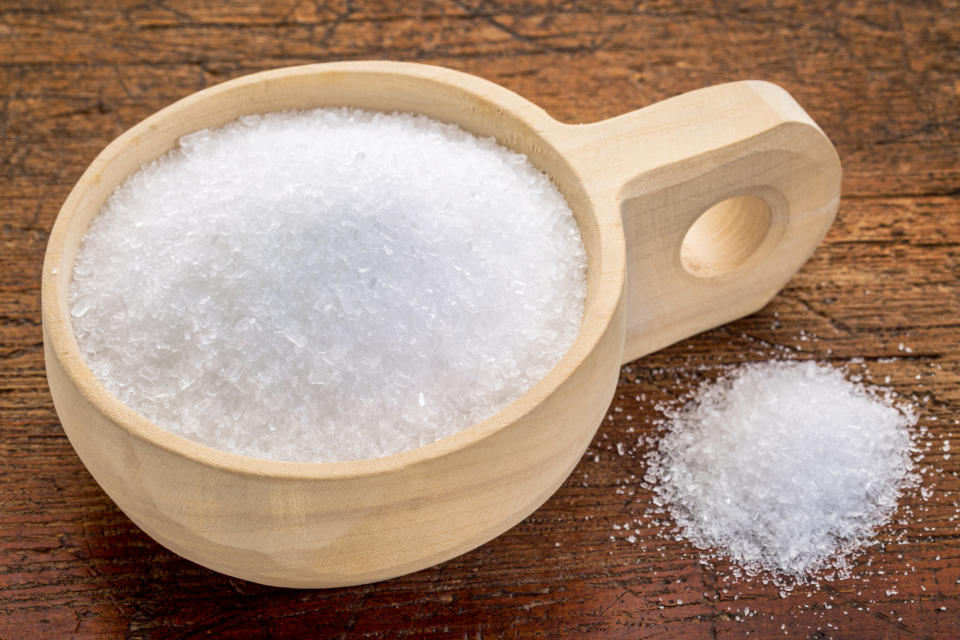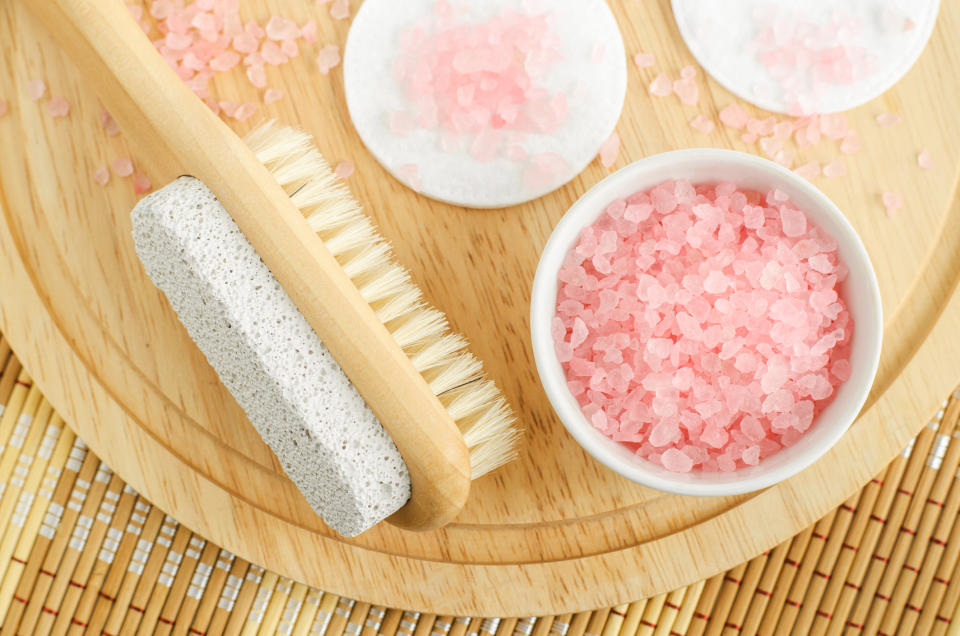The Bath Add-In That Makes Any Soak Instantly More Soothing
After a long day, there’s no greater "me time" than unwinding in a warm bath, particularly during the colder season when soaking in a tub is the only way to get that chill out of your bones. Baths not only wash a stressful day away and warm you up, but add in some nutrient-infused extras and they're a great way to provide the body with essential minerals that we need to function and feel better. One especially transformative ingredient you can enhance your bath with? Bath salts. Keep scrolling for bath salt recipes that incorporate skin-safe ingredients into your soak for a gentle, moisturizing and ahh-filled soak.
What are bath salts and what are their benefits?

“Bath salts, which include epsom salts (magnesium sulfate), sea salts and Himalayan salts, serve as a conduit for carrying essential minerals into our system,” explains Amy Wall, an award-winning esthetician and skincare specialist based in Little River, California. “Dissolved in warm bath water, these minerals contribute to joint and muscle health, which reduces inflammation and alleviates skin ailments.”
Additionally, bath salts stimulate your circulation, ease muscle cramps “and help to relieve our stiff, achy joints,” says Deborah Hamel, lead massage therapist and corporate trainer at Georgia’s Woodhouse Spa Dunwoody. “They soothe our overworked areas and help us return to homeostasis (balance) in our bodies. Bath salts also play a beneficial role in detoxing the body’s largest organ — our skin.”
Related: 6 DIY Bath Soaks That Will Thicken Hair, Ease Eczema, Banish Bloat, and More
What salts are best to use for bath salt recipes
Thankfully, there’s a plethora of bath salts — and bath salt recipes — out there, each with its own unique mineral composition and therapeutic advantages.
1. Best for sensitive skin and sore muscles: Epsom salts

Epsom salts (Buy from Walmart, $4.12) are packed with magnesium sulfate, which assists in muscle relaxation, inflammation reduction and enhancing quality of sleep. (Click through for more uses for epsom salts).
Bath salt recipe using Epsom salt

1 cup Epsom salt
? cup dry oatmeal (Its anti-inflammatory properties make it effective in soothing irritated skin caused by eczema, psoriasis, insect bites or rashes. It can help reduce itching and redness, providing relief.)
10-15 drops rose essential oil (It's rich in vitamins, antioxidants and emollient properties that can help moisturize and hydrate skin.)
To do: Mix ingredients in a bowl and use about ? cup to 1 cup per bath, ensuring it dissolves. According to Wall, in baths, oatmeal is “renowned” for its anti-inflammatory properties and is ”excellent for sensitive skin.” Rose, she adds, is hydrating and calming to the nervous system, “as well as the highest vibratory flower.”
Related: Here’s How to Harness The Skin-Saving Powers of Epsom Salt
2. Best for rashy skin: Dead Sea salt
The high concentration of minerals in the Dead Sea are what gives Dead Sea salt (Buy from Amazon, $9.99) its powers. Filled with minerals like magnesium, calcium, potassium and bromide, according to Wall, this type of salt can help alleviate conditions such as psoriasis, eczema and arthritis.
Bath salt recipe using Dead Sea salt
1 cup Dead Sea salt
2? Tbs. baking soda (It has anti-inflammatory properties and may help soothe irritated skin. It can be particularly beneficial for conditions like sunburn, rashes or itching.)
10-12 drops of lavender essential oil (It can help relax your body and mind, reducing stress and anxiety.)
To do: Mix Dead Sea salt and baking soda together, then add the 10-12 drops of lavender essential oil and add to bath.
3. Best for super dry skin: Himalayan salt

Himalayan salts (Buy from Amazon, $11.49) contain an extensive range of 84 trace minerals that aid in detoxifying the body and harmonizing systemic pH. Plus, Himalayan salts have natural exfoliating properties. They can help remove dead skin cells, leaving the skin feeling smoother and softer when you step out of the bath.
Bath salt recipe using Himalayan salt
? cup Himalayan salt
15 drops of any uplifting essential oils
2 Tbs. almond oil (It can diminish the appearance of scars and stretch marks over time.)
To do: Stir all ingredients together. Use ? cup of this mix per bath.
4. Best for overall detox: Grey bath salts
Less mainstream but still a hidden gem is all-natural grey bath salt (Buy from Candles and Supplies, $14.99). “Grey bath salt is traditionally hand-harvested in Guérande, France, in the Brittany region. Unwashed, unrefined and additive-free, French grey bath salt maintains all its health-enhancing nutrients vital to the human body like calcium, potassium, copper, zinc, iron and others,” explains Bobbie Cunningham, a licensed esthetician and co-owner of botanical beauty brand FABLERUNE. “At FABLERUNE, we love to use sea salt in the winter months, where it’s a little hard to connect directly with nature and we need support grounding ourselves.”
Bath salt recipe using grey bath salts
? cup French grey bath salt
? cup Epsom salt
1 Tbs. kaolin clay (It helps pull toxins from skin for a blemish-free glow.)
2 Tbs. jojoba or sweet almond oil
6 drops of lavender oil
4 drops of tea tree oil (It's an antibacterial commonly used to treat acne, athlete's foot, nail fungus and more.)
To do: In a medium mixing bowl, combine the salts and clay. In a small glass container, add the essential oils to the jojoba or sweet almond oil and stir. Pour the oils into the bowl with the dry ingredients and blend well. "Pour the bath salt blend into your warm bath. Sit in the bath for 20-30 minutes and relax. Follow your bath with a glass of water to hydrate your body after the detox," says Adriana Green, founder and formulator of beauty brand Esteli.
Ingredients to avoid when making bath salt recipes
Before making your own bath salts, Wall shares some important advice: “Avoid adding harsh or synthetic substances, fragrances and colors, as they hold potential for skin irritation, drying, allergic reactions and hormone disruption.”
Wall also says to avoid any abrasive components that might harm the skin, “such as parabens, phthalates, sodium lauryl sulfate (SLS) and petroleum products.” Read the ingredients on any bath product you buy very carefully.
TIP: Avoid any recipe using hydrogen peroxide (a common ingredient in many bath bombs on the market). “Hydrogen peroxide can disrupt the balance of vaginal microflora, leaving you susceptible to a UTI or a vaginal yeast infection,” explains Hamel. “Also try to avoid BHT, which is a synthetic preservative some companies put in their body products to reduce costs.” Additionally, she adds: “Opt for bath products that use citric acid, instead of boric acid.”
Related: Gynecologist: If You're Always Tired & Over 50, You May Have a 'Silent UTI'
Woman's World aims to feature only the best products and services. We update when possible, but deals expire and prices can change. If you buy something via one of our links, we may earn a commission. Questions? Reach us at [email protected]
For more on self care, click through these stories:
“I Tried the ‘Everything Shower’ and Loved How It Made Me Look and Feel!”
Why Women Are Choosing ‘Dry Oils’ to Hydrate and Beautify Their Skin + 3 Top Picks Under $20
